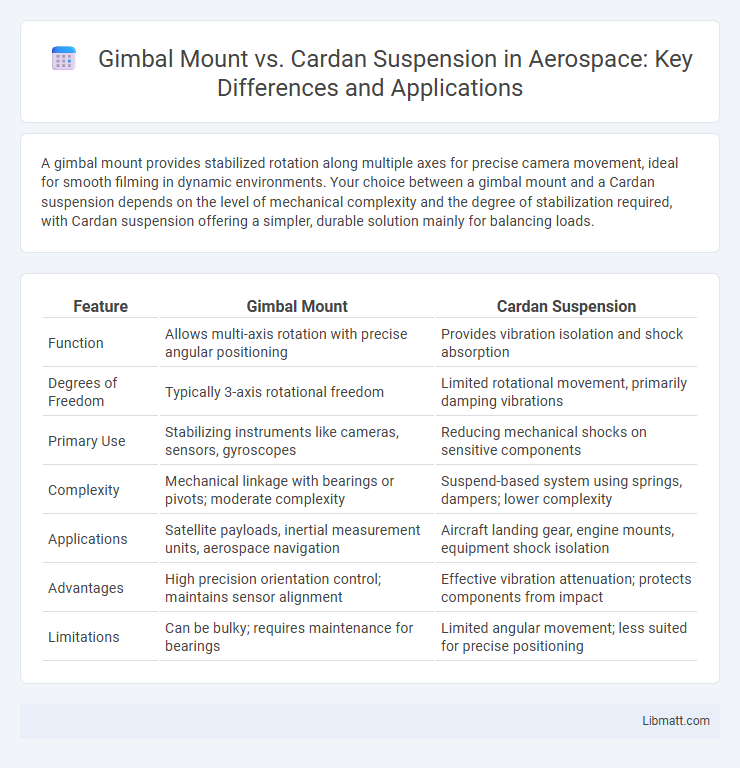A gimbal mount provides stabilized rotation along multiple axes for precise camera movement, ideal for smooth filming in dynamic environments. Your choice between a gimbal mount and a Cardan suspension depends on the level of mechanical complexity and the degree of stabilization required, with Cardan suspension offering a simpler, durable solution mainly for balancing loads.
Table of Comparison
| Feature | Gimbal Mount | Cardan Suspension |
|---|---|---|
| Function | Allows multi-axis rotation with precise angular positioning | Provides vibration isolation and shock absorption |
| Degrees of Freedom | Typically 3-axis rotational freedom | Limited rotational movement, primarily damping vibrations |
| Primary Use | Stabilizing instruments like cameras, sensors, gyroscopes | Reducing mechanical shocks on sensitive components |
| Complexity | Mechanical linkage with bearings or pivots; moderate complexity | Suspend-based system using springs, dampers; lower complexity |
| Applications | Satellite payloads, inertial measurement units, aerospace navigation | Aircraft landing gear, engine mounts, equipment shock isolation |
| Advantages | High precision orientation control; maintains sensor alignment | Effective vibration attenuation; protects components from impact |
| Limitations | Can be bulky; requires maintenance for bearings | Limited angular movement; less suited for precise positioning |
Introduction to Gimbal Mount and Cardan Suspension
A gimbal mount is a pivoted support system that allows an object to rotate freely along multiple axes, providing stability and smooth motion often used in cameras and navigation instruments. Cardan suspension, named after Gerolamo Cardano, is a mechanical linkage that permits rotation between two shafts while accommodating misalignment, commonly found in automotive drive shafts and machinery. Understanding these systems helps you select the right solution for maintaining orientation and reducing vibrations in dynamic environments.
Historical Origins and Development
Gimbal mounts trace their origins to ancient Greece, where they were used in ship navigation to stabilize compasses by allowing rotation on multiple axes. Cardan suspension, developed in the 16th century by Italian mathematician Gerolamo Cardano, expanded on this concept to provide universal joints for transmitting rotary motion in mechanical systems. Both innovations laid foundational principles for modern stabilization and mechanical articulation technologies, evolving through improvements in precision engineering and materials.
Basic Construction of Gimbal Mount
The basic construction of a gimbal mount features a set of three rings pivoted at right angles to each other, allowing an object to remain stable and rotate freely along multiple axes. Each ring supports the inner ring, creating a pivot system that provides precise and smooth rotational movement, essential for applications like cameras and compasses. This design contrasts withCardan suspension by offering enhanced stability through balanced pivots and reduced resistance during rotation.
Core Design Features of Cardan Suspension
Cardan suspension features a universal joint allowing rotational movement in multiple axes, providing smoother stabilization compared to fixed mounts. Its core design includes cross-shaped arms connected by bearings, enabling precise angular adjustments to counteract vibrations and maintain balance. Understanding these mechanisms helps you choose a suspension system that enhances motion stability and reduces unwanted sway in your equipment.
Functional Principles Compared
Gimbal mounts operate by allowing an object to rotate freely along multiple axes through a system of pivoted rings, providing precise stabilization and orientation control. Cardan suspensions use a similar three-axis pivot mechanism but are primarily designed to isolate vibrations and maintain a fixed orientation despite external movement. The key functional difference lies in gimbal mounts enabling active rotational adjustment, whereas Cardan suspensions emphasize passive stabilization and shock absorption.
Applications in Modern Technology
Gimbal mounts provide precise rotational control ideal for camera stabilization in drones, virtual reality headsets, and robotics, enabling smooth and responsive motion tracking. Cardan suspensions, often used in vehicle drive shafts and aerospace engineering, excel at accommodating angular misalignment and reducing vibration during rotational movement. Your choice between these systems depends on the required application, balancing stability with mechanical flexibility in modern technology solutions.
Advantages of Gimbal Mount Systems
Gimbal mount systems provide superior rotational stability and precision control by allowing unrestricted movement around multiple axes, which enhances camera or instrument maneuverability in dynamic environments. They reduce vibration and unwanted motion more effectively than traditional cardan suspensions, ensuring smoother footage and more accurate sensor readings. Their compact design and solid-state components offer greater durability and reduced maintenance requirements compared to cardan suspension setups.
Benefits of Cardan Suspension Mechanisms
Cardan suspension mechanisms offer superior stability by isolating vibrations and rotational movements across multiple axes, enhancing precision in applications such as cameras, aerospace, and robotics. Their ability to maintain consistent orientation regardless of platform motion minimizes image blur and sensor errors, crucial for high-performance tracking and navigation systems. Compared to gimbal mounts, Cardan suspensions provide smoother, more reliable operation under dynamic conditions, improving overall system durability and operational accuracy.
Key Differences in Performance
A gimbal mount provides superior stabilization by allowing rotation around multiple axes independently, resulting in smooth and precise motion control ideal for camera work and surveying equipment. Cardan suspension, often used in vehicle and machinery applications, offers robust shock absorption by using a system of linked arms to reduce vibrations and mechanical stress. Your choice depends on whether precise rotational stability or effective vibration dampening is the priority for your project.
Choosing the Right System for Your Needs
Choosing the right system depends on your specific stabilization requirements and application context. A gimbal mount offers precise, multi-axis control ideal for smooth video capture in dynamic environments, while a cardan suspension excels at isolating vibrations and providing mechanical stability in industrial or vehicular settings. Understanding your priority--whether it's fine motion control or heavy-duty shock absorption--will guide you to the optimal choice for your setup.
gimbal mount vs cardan suspension Infographic

 libmatt.com
libmatt.com